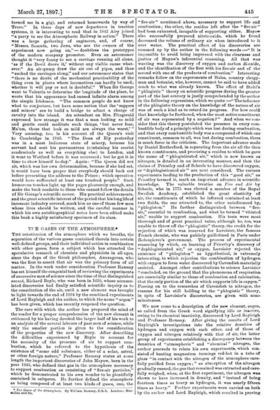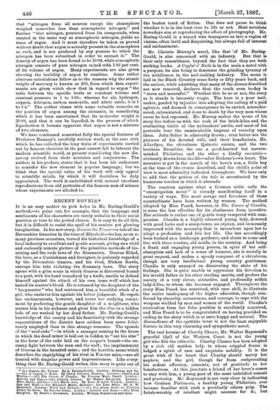TF E GASES OF THE ATMOSPHERE.*
THE constitution of the atmosphere which we breathe, the separation of the various gases contained therein into certain well-defined groups, and their individual action in combination with other gases, form a subject which has attracted the speculative research of chemists and physicists in all ages, since the days of the Greek philosopher, Anaxagoras, who was the first to assert that air was the primary form of all matter. In the work under consideration Professor Ramsay has set himself the congenial task of reviewing the experiments of successive men of science since the time of that distinguished savant, Richard Boyle, who was born in 1626, whose accumu- lated discoveries had finally satisfied scientific inquiry as to the constitution of the air, until a new element was brought to light towards the end of 1894 by the combined experiments of Lord Rayleigh and the author, to which the name "argon" has been given, which has recently reopened the question.
The care with which the author has prepared the mind of the reader for a proper comprehension of the new element is evidenced by his having devoted the larger half of his work to an analysis of the several labours of past men of science, while only the smaller portion is given to the consideration of the properties of the new discovery. After describing the difficulties experienced by Boyle to account for the necessity of the presence of air to support com- bustion, which he referred to the hypothesis of the existence of "some odd substance, either of a solar, astral, or other foreign nature," Professor Ramsay states at some length the important discoveries of John Mayow, born in the year 1645, who defined that gas in the atmosphere necessary to support combustion as consisting of "fire-air particles," which he demonstrated to his own wonder to be plentifully contained in saltpetre. He further defined the atmosphere as being composed of at least two kinds of gases, one, the
• The Gases of the Atmosphere. By William Ramsay, P.R.S. London: Mac- millan and Co.
"fire-air" mentioned above, necessary to support life and combustion ; the other, the residue left after the " fire-air " had been exhausted, incapable of supporting either. Mayow also successfully prepared nitric-oxide, which be found decreased the volume of ordinary air when introduced to it over water. The practical effect of his discoveries are
summed up by the author in the following words It is impossible to avoid being impressed with the clearness and justice of Mayow's inferential reasoning. All that was wanting was the discovery of oxygen and carbon di-oxide, and the identification of the first with his fire-air and of the second with one of the products of combustion." Interesting remarks follow on the experiments of Hales, country clergy- man and botanist, who, however, cannot be said to have added much to what was already known. The effect of Stahl's " phlogistie " theory on scientific progress during the greater part of the last century is justly comprehended by the author in the following expressions, which we quote :—" The influence of the phlogistie theory on the knowledge of the nature of air was of such a kind as to retard its progress. For how could that knowledge be furthered, when the most active constituent of air was represented by a negation ? " And when we con- sider that this theory postulated the presence in every com- bustible body of a principle which was lost during combustion, and that every combustible body was a compound of which one constituent, common to all, was lost during combustion, there is much force in the criticism. The important advance made by Daniel Rutherford, in separating from the air all the then known constituents, and procuring a residue to which he gave the name of " phlogisticated air," which is now known as nitrogen, is detailed in an interesting manner, and then the claims of Priestley and of Scheele to have discovered oxygen, or " dephlogisticated air" are next considered. The various experiments leading to the production of this "good air," as Priestley termed it, mark an important advance in scientific knowledge. The valuable treatise on Fire and Air by Scheele, who in 1775 was elected a member of the Royal Swedish Academy, established the great elasticity of air, the constituents of which he inferred contained at least two fluids, the one attracted to, the other uninfluenced by, "phlogiston." He further distinguished between "fire- air," essential to combustion, and what he termed "vitiated air," unable to support combustion. His tests were most thorough and of great practical value, although he, too, was unable to throw off the "phlogistie theory, the credit for the rejection of which was reserved for Lavoisier, the famous French chemist, who was publicly guillotined in Paris under Robespierre's government. The process of experimental reasoning by which, on learning of Priestley's discovery of " dephlogisticated air," or oxygen, Lavoisier rejected the existence of " phlogiston " as hypothetical, is extremely interesting, to which rejection the combination of hydrogen. with oxygen to form water discovered by Cavendish materially assisted. Amongst other contributions to science Lavoisier " concluded, on the ground that the phenomena of respiration are essentially similar to those of combustion and cakination, that the only portion of the air which supports life is oxygen." Passing on to the researches of Cavendish in nitrogen, the reasons for his still holding to the " phlogistic " theory, in spite of Lavoisier's discoveries, are given with some minuteness.
We now come to a description of the new element, argon, so called from the Greek word signifying idle or inactive, owing to its chemical inactivity, discovered by Lord Rayleigh and Professor Ramsay. After giving the results of Lord Rayleigh's investigations into the relative densities of hydrogen and oxygen with each other, and of those of oxygen and nitrogen relatively with that of air, the latter group of experiments establishing a discrepancy between the densities of "atmospheric" and "chemical" nitrogen, the author proceeds to relate his own experiments, which con- sisted of heating magnesium turnings red-hot in a tube of glass "in contact with the nitrogen of the atmosphere care- fully purified from oxygen ; " as absorption of the nitrogen gradually ensued, the gas that remained was extracted and care- fully weighed, when, at the first experiment, the nitrogen was shown to have increased in density, and "instead of being fourteen times as heavy as hydrogen, it was nearly fifteen times as heavy." Further experiments were carried on both by the author and Lord Rayleigh, which resulted in proving
that "nitrogen from all sources except the atmosphere weighed somewhat less than atmospheric nitrogen," and further "that nitrogen, procured from its compounds, when treated in the same way as atmospheric nitrogen, yields no trace of argon. And it must therefore be taken as proved without doubt that argon is actually present in the atmosphere as such, and is not produced by any process to which the nitrogen has been submitted in order to extract it." The density of argon has been found to be 1994,. while atmospheric nitrogen consists of pure nitrogen mixed with 136 per cent. of its volume of argon. Many experiments are also given showing the inability of argon to combine. Some rather abstruse calculations follow as to the reasons why the atomic weight of mercury is known as 200, from which data experi- ments are given which show that in regard to argon "the ratio between the specific heats at constant volume and constant pressure is 1 to 1.66; whereas for air, hydrogen, oxygen, nitrogen, carbon monoxide, and nitric oxide, it is 1 to 14." The author closes with some valuable remarks on the position of argon among the elements, in considering which it has been ascertained that its molecular weight is 39.88, and that it can be liquefied, in the process of which liquefaction it became apparent that argon is not a mixture of two elements.
We have condensed somewhat fully the special features of Professor Ramsay's carefully written work, as the care with which he has collected the long train of experiments carried out by famous chemists in the past cannot fail to interest the modern scientific world, at present considering the new dis- covery evolved from their mistakes and conjectures. The author, in his preface, states that it has been his endeavour to consider the new element in popular language ; but we think that the special value of his work will only appeal to scientific minds, by which it will doubtless be duly appreciated. The work is embellished with several excellent reproductions from old portraits of the famous men of science whose experiments are alluded to.







































 Previous page
Previous page